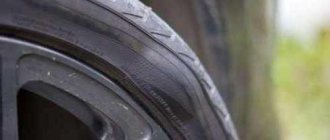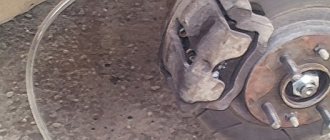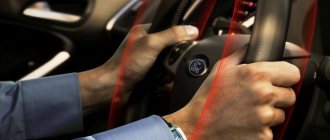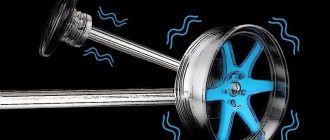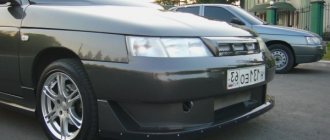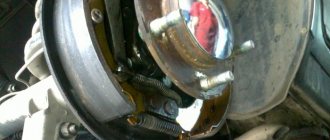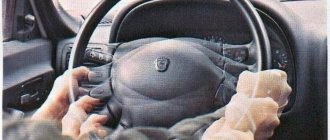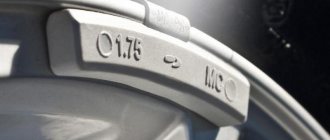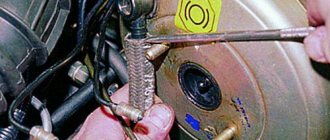The braking system is one of the main components of a car, which allows you to respond in a timely manner to obstacles while moving in traffic without causing emergency situations. A slow response to pressing the pedal can cause a collision with the car in front, and too sharp a response will interfere with cars behind. And in general, any malfunction in the brake system invariably leads to a decrease in pedal response time, the driver cannot predict the movement of the car and the chance of getting into an accident increases sharply. One of the manifestations of a malfunction in the brake system may be that the Chevrolet Niva brake pedal hits when braking. If this problem occurs, you should immediately diagnose the brake system and fix the problem.
Where does steering wheel wobble come from?
Steering wheel beating at the moment of braking means spontaneous jerking of the steering wheel in different directions. In especially advanced cases, the vibration is so strong that the driver has to literally catch the car on the road. At speeds above 50 km/h, the phenomenon creates a real danger for vehicle passengers.
Since the steering wheel is rigidly connected to the front wheel hubs through a rack and ball ends, the source of the problem must be sought in the chassis and braking system of the car. The main causes of strong vibration lie in various defects of the brake disc:
- the working part of the product is deformed and has a wavy surface;
- due to the impact, the disk was damaged and cracked;
- The spare part was originally defective or installed incorrectly.
Ball joints
Experienced car enthusiasts recommend carefully checking the entire chassis.
The reason could be hidden anywhere. Thus, there are frequent cases when the brake pedal hits when braking (VAZ-2114 is no exception) due to a faulty or worn ball joint. This is the first thing to check.
For inspection, the car is jacked up, and the ball joint is installed so that the wheel hangs in the air. Then, with the palm of one hand, take the wheel by the upper part, and with the other hand, by the lower part. You need to wobble the wheel with your hands. If the wobble is present and felt, then the ball joint must be replaced. This should eliminate vibrations and knocking.
Other causes of vibration
Steering wheel vibrations that are not associated with the car jerking in different directions appear for the following reasons:
- One of the vehicle's process fluids, for example, transmission oil, got on the pads as a result of oil seal wear. Possessing significant viscosity, the lubricant adheres well to any surface and disrupts the normal operation of the brakes when the pedal is pressed sharply.
- The internal elements of the steering rack have worn out, and significant play has appeared.
- The steering rod ball pins have become unusable.
- Inoperability of shock absorbers and front struts. Vibration on the steering wheel is felt when braking sharply and at the same time entering a turn.
Note. Problems associated with wear of ball joints and shock absorbers also appear on the wheels of the rear axle. Most often, brake fluid gets on the pads, the reasons are faulty working cylinders and leaky rubber cuffs.
A strong side impact of any wheel on a high curb (for example, due to ice or an accident) can lead to deformation and subsequent vibration. The main load is taken by the disk, wheel bearing and various suspension joints. Any of the listed parts can become cracked and cause the steering wheel to vibrate during braking.
Conclusion
Engine vibration can indicate many problems in various parts of the car. This includes the brake, the chassis, the steering mechanism itself, and sometimes even engine fasteners. Since vibrations only indicate something more, a car enthusiast should never ignore the problem - he needs to plan a trip to a service station and carry out repair work as early as possible. The car owner can do only a few things on his own: check the brakes and wheels, lubricate the brake mechanisms, replace the rod ends or tighten the steering rack, and also check the condition of the boots and silent blocks.
vote
Article rating
How is a malfunction diagnosed?
To identify the runout of one of the front wheels, you will need a jack, wheel chocks and a wheel wrench. The diagnostic procedure is as follows:
- Park the machine on level ground and pull the handbrake all the way. Additionally, secure the car with boots placed under any rear wheel.
- Jack up the front wheel until it hangs off the ground. On vehicles with front-wheel drive and all-wheel drive, be sure to move the gearshift lever to neutral.
- Rotate the suspended rim with your hands. If you feel stuck in a certain position, remove the wheel and check that the uneven disc is rubbing against the pads, causing strong vibration when braking.
The essence of the diagnosis is simple: after operation, the brake pads move back just enough to free the rotating surfaces. The lining must be forced apart to its maximum open position. If the metal working part is bent, then when rotating the part will begin to get stuck between the pads.
Advice. It is not a fact that jerking of the steering wheel in different directions is caused by deformation of one disc. It is likely that the second element is also bent. Therefore, be sure to check both front mechanisms for defects. At the same time, inspect the parts for cracks (especially after a side impact).
If the vibration does not cause the car to deviate from a straight path while driving and does not cause the steering wheel to twitch, check the suspension and chassis components. Drive the vehicle into the inspection ditch and jerk the steering rods to check for play. The performance of shock absorbers is checked by rocking the car up and down with body weight. After applying force, the machine should swing no more than 1 time.
Communities › Chevrolet Niva › Blog › Question! Hit the brake pedal.
Hi all. I ask for help, because I don’t know what to think anymore. When braking at speed does it hit the brake pedal? The following was done: 1. Replacement of the silent blocks of the upper arms 2. Replacement of all balls 3. Replacement of brake discs 4. Replacement of front brake pads 5. Replacement of the right hub with bearing 6. Replacement of brake drums
The following were checked: 1. All drives - everything is OK 2. Cardans - there is a slight play in the spline, but not critical 3. Diagnostics of the chassis - everything is OK
In short, I don’t know what to do anymore, it kept beating (((at speeds up to 80 it’s still not critical, but braking from 120 is almost impossible, it feels like the car will fall apart. When braking from speed, the steering wheel also wobbles... Yes, the steering linkage too new! In general, I’m waiting for practical advice, otherwise it’s so scary to drive... Thanks in advance!
How to eliminate runout?
When your car's steering wheel vibrates slightly during heavy braking, you can simply do nothing and drive on, taking appropriate safety measures. The trick is to avoid decelerating too quickly, otherwise the problem will get worse and you risk losing your vigilance and running off the road.
Recommendation. Before further operation of the car, make sure that the culprit of the steering wheel runout is a defect in the brake disc, and not other reasons.
If the beating is quite noticeable and really threatens the safety of people (vehicle passengers and pedestrians), the deformed disk should be replaced or restored. The first way is associated with significant financial costs - spare parts for some brands of cars are quite expensive. In addition, the brake discs must be replaced in pairs, otherwise during moments of sharp deceleration the front part of the car will begin to pull to the side.
Disc restoration involves turning on a specialized machine . The equipment of advanced service stations makes it possible to process metal without removing the defective part from the machine. The procedure will be cheaper than purchasing and installing new spare parts.
When the car shakes when braking, regardless of speed, you need to look for and fix the problem elsewhere:
- Make sure that the linings of the rear and front wheels are not flooded with brake fluid. A secondary symptom is a decrease in its level in the expansion tank.
- Check the functionality of the brake calipers and wheel cylinders. The cause of vibration is often a jammed piston, and fluid leaks are often caused by a leaky cuff.
- Sometimes the steering wheel starts to vibrate after replacing the pads. This symptom indicates low quality of installed spare parts.
In some cases, vibration appears due to broken brake pads. The malfunction is accompanied by an extraneous sound of grinding or rubbing against metal.
The safety of the driver and passengers depends on the technical condition of the car. Minor structural damage that causes vibrations in the steering wheel when braking can lead to serious consequences. In most cases, the driver diagnoses the breakdown on his own or goes to a car service center.
The most likely cause of vibration is the condition of the brake discs. But this is not always the case. The culprit may be deformation of the steering racks or the formation of a hernia on one of the wheels.
Tags: brakes, beat, pedal, brake
Comments 73
How did you overcome this adversity?
I have the same problem, when I press the pedal, it hits the pedal and the right front wheel. I’ve been struggling with it for a long time, everything except the tubes and hoses was replaced. The service center advised me to replace the front hoses, they said that they had 2 such cases. I haven’t changed it yet , no time, try to tell me.
The problem appeared after replacing the front hubs with bearings from BMW, I bought a set and replaced them along with the disks. For some reason these parts did not arouse suspicion, as it turned out in vain and after all it was a crooked hub, I had to look for where to buy only one hub, I found it, changed it, everything is good.
Check the adjustment of the front hubs (there may be a lot of play). Try changing the brake pads. And since everything was recently changed, then look to see if everything is screwed back together. Did this problem exist before the repair? Have you done a wheel alignment adjustment? You can hang the car up and with the wheels removed see if the brake discs and drums are hitting. Maybe a defective batch arrived and you are scratching your head.
By the way, during installation, it is possible that dirt stuck to the axle shaft and the drum stood up crookedly. It’s easy to check. I don’t think there’s any need to explain. But it’s 99.9 percent that the disc is an egg. I switched to rear disc brakes because of these egg-shaped drums
Rear drums. They and only them. Just because they're new doesn't mean they're round. Methods of treatment 2. remove and change or remove and take it to a turner. Ignore what hits the steering wheel for now until it disappears into the pedal. The steering wheel hits because of the front curves. But in your case, perhaps because of the rear ovals, the pulsating braking of the front brakes is transmitted to the steering wheel.
I had the same problem, everything went away after replacing the drum brakes with disc brakes.
Why does the steering wheel vibrate when braking?
Before self-diagnosis, you should think about what preceded the appearance of the beating. Has the chassis system been repaired or brake pads replaced? It is worth starting to identify the breakdown with replaced parts. They may be made from low quality materials.
It is also important to consider the experience of the technician who performed the repair. Failure to comply with installation technology leads to increased loads. Not only the replaced part suffers, but also the system as a whole.
Did the steering wheel wobble after driving through puddles or fresh snow? Pay attention to the condition of the brake discs. Temperature changes lead to surface deformation.
Does the steering wheel exhibit a large range of motion and become difficult to hold? With a 99% probability, the problem lies in broken brake discs or improper bleeding of the system. In such a situation, urgent repairs are necessary. The wheels react differently when you press the brake pedal. The likelihood of getting into an accident increases, and driving the car becomes uncomfortable even for an experienced driver.
Reasons for vibrations in the steering wheel:
- Wear of brake discs.
- Technical condition of the running system.
- Hernia or deformation of the wheels.
- Nuts not tightened tightly.
Before detecting deformation of the steering rod or wear of the brake disc, you should pay attention to the fastening of the wheels. In most cases, the cause of wobbling is not that they are poorly secured. But if the problem is just one loose nut, then it will be unpleasant to find out after a full repair.
Summarizing
The vibration of the brake pedal when braking is one of the symptoms of a malfunctioning brake system. The consequences can be very different from simple wear of parts to the creation of emergency situations due to brake failure.
For full operation of the brake system, full contact between the surface of the friction lining of the pad and the brake disc is necessary. If replacing worn parts helped only temporarily, maybe you should think about changing your driving style, because it is your driving style that affects the service life of the parts.
You should also not allow the temperature of heated elements (discs and calipers) to change; try to avoid puddles after braking, and also allow the brakes to cool before washing the car. To avoid breakdowns, you should visit service stations more often to check the performance and preventive maintenance of brake mechanisms, repair them in a timely manner, and also periodically inspect your brakes yourself.
You can test and find any faults in the brake system in your car on an empty section of the road, away from houses and pedestrians in order to avoid accidents.
How to determine wear of the chassis and other breakdowns?
Is the failure at the front, but the tested discs are in perfect condition? A visual inspection of the chassis system allows you to find a breakdown. Tie rods and ends are likely causes of steering wheel wobble.
It will be difficult for an inexperienced person to notice the deformation of the structure. But if you notice unnatural bends, then the reason for the vibrations becomes clear. In less severe cases, it is necessary to rely on inspection and evaluation of the system as a whole.
A herniated or deformed tire is easily detected visually even by an inexperienced driver. There shouldn't be any problems with this. If there is no visible damage, it will be useful to remove the wheel and examine the surface from the inside.
What to do if the brake system is working properly.
If a visual inspection does not reveal any faults, or after replacing any elements the problem still persists, you need to check the following elements:
- wheel balancing.
- suspension arms, their fastenings
- brake system fastening elements
Problems with the brake system should not be ignored. In the future, this can lead to more expensive repairs or accidents on the roads.
How to solve the problem with vibrations in the steering wheel?
When brake discs wear out, there are 2 ways to solve the problem. Grooving and replacement. By changing an element of the system, you can forget about the steering wheel beating for a long time. Grooving allows you to get rid of vibrations and keep your budget safe. But the working life of the disk will decrease and a repeat procedure may soon be required.
It is recommended to replace on both sides at the same time. This way you will achieve the best effect and eliminate steering wheel beating.
Deformation of the steering rod, ends, brake calipers - replacement of the part that has become unusable is mandatory. Actions to give the spare part its original technical characteristics are doomed to failure. The effectiveness of such measures is extremely low.
In situations with tire damage, everything depends on the degree of wear and experience of the technician. Often the problem is resolved quickly and without undue burden on the budget.
What could have happened to the drums?
Well, in general, what can happen to the drums is that they become crooked. This may be caused by excessive wear on the pads or the fact that the drums were already crooked and began to progress.
This happens when you take low-quality spare parts. At first, a slight, barely noticeable vibration appears, which becomes increasingly stronger, and maybe even completely - it hits quite hard when braking immediately after installation.
However, the beating of the drums is curable, but how to calculate exactly the drums, especially if there is no special indicator.
However, you can define it like this:
Why are vibrations in the steering wheel when braking dangerous?
In most cases, the breakdown does not require immediate repair. By eliminating emergency braking, the car can be used even for several years. But there is an increased load on the chassis system, it is important to realize this.
By refusing to make repairs, you may end up having to spend a lot of money in the future. An important aspect is the pleasure derived from driving a car. The vibration of the steering wheel does not allow you to fully enjoy the trip.
The optimal solution in this situation is to carry out repairs if funds are available. The problem does not require urgent replacement of parts. But by constantly postponing repairs, you reduce your comfort and increase its cost.
Two ways
There are two ways to find out what is beating - discs or drums - hang the wheels one at a time, accelerate and brake. Don't forget to turn off the lock, otherwise you'll ram the garage!
I used another one - I went down into the pit, pulled the handbrake and went to test it. We accelerate to 120, slowly pull the handbrake and watch. There's a familiar vibration - congratulations! Rear rams and pads need to be replaced.
Someone might argue with me that the rams have no effect on the steering wheel. Perhaps you are right, but with crooked drums my steering wheel was shaking, oddly enough. Perhaps the steering wheel was simply jerking along with the body.
The shank nut has come loose
Attention! Operating a machine with such a malfunction is strictly prohibited!
And this is the most dangerous malfunction, due to which the gearbox breaks or the axle jams while driving. If you hear a hum or howl that only appears when you release gas on the Niva, then this is 100% the shank nut or shank bearing, which affects its movements in the same way. This hum is reminiscent of a trolleybus approaching a stop.
If this problem is detected, it is recommended to immediately go to the repair site and fix the problem - tighten the nut. Another symptom of the problem is a leaking shank seal.
Chevy Niva transmission hum - needs to be removed
Because You are not logged in. To come in.
Because you are not a trust user. How to become a trustee.
Because The topic is archived.
Because You are not logged in. To come in.
Because you are not a trusted user (phone number is not verified). Enter and confirm your phone number. Read more about trusts.
Because The topic is archived.
Because You are not logged in. To come in.
Because you are not a trusted user (phone number is not verified). Enter and confirm your phone number. Read more about trusts.
Because The topic is archived.
Because You are not logged in. To come in.
Because you are not a trusted user (phone number is not verified). Enter and confirm your phone number. Read more about trusts.
Because The topic is archived.
Because You are not logged in. To come in.
Because you are not a trusted user (phone number is not verified). Enter and confirm your phone number. Read more about trusts.
Because The topic is archived.
Because You are not logged in. To come in.
Because you are not a trusted user (phone number is not verified). Enter and confirm your phone number. Read more about trusts.
Because The topic is archived.
Because You are not logged in. To come in.
Because you are not a trusted user (phone number is not verified). Enter and confirm your phone number. Read more about trusts.
Because The topic is archived.
Because You are not logged in. To come in.
Because you are not a trusted user (phone number is not verified). Enter and confirm your phone number. Read more about trusts.
Because The topic is archived.
Because You are not logged in. To come in.
Because you are not a trusted user (phone number is not verified). Enter and confirm your phone number. Read more about trusts.
Because The topic is archived.
Because You are not logged in. To come in.
Because you are not a trusted user (phone number is not verified). Enter and confirm your phone number. Read more about trusts.
Source
Rumble in the rear axle of the Niva Chevrolet. It can be different. An easy way to determine causes by symptoms
Bridges are also quite weak parts of the Niva. You can pay a big price by mocking these mechanisms and, as a rule, problems with the bridge begin to manifest themselves in the form of a hum. However, the hum and howl of the bridge can have a different character and indicate different breakdowns. I'll try to sort everything out.
At the moment, there are several types of rear axle malfunctions that cause howling:
- Main pair wear
- Bearing failure
- Shank nut
- Irregularities in gearbox adjustment
Depending on the cause, symptoms will vary. But I’ll say right away: the hum cannot be cured by changing the oil, additives and other liquids that are sold to us on TV. Worn bearings and teeth of the main pair cannot be healed with a magic potion. Alas, this has not yet been invented. Therefore, discard these options and listen to the nature of the malfunction.
